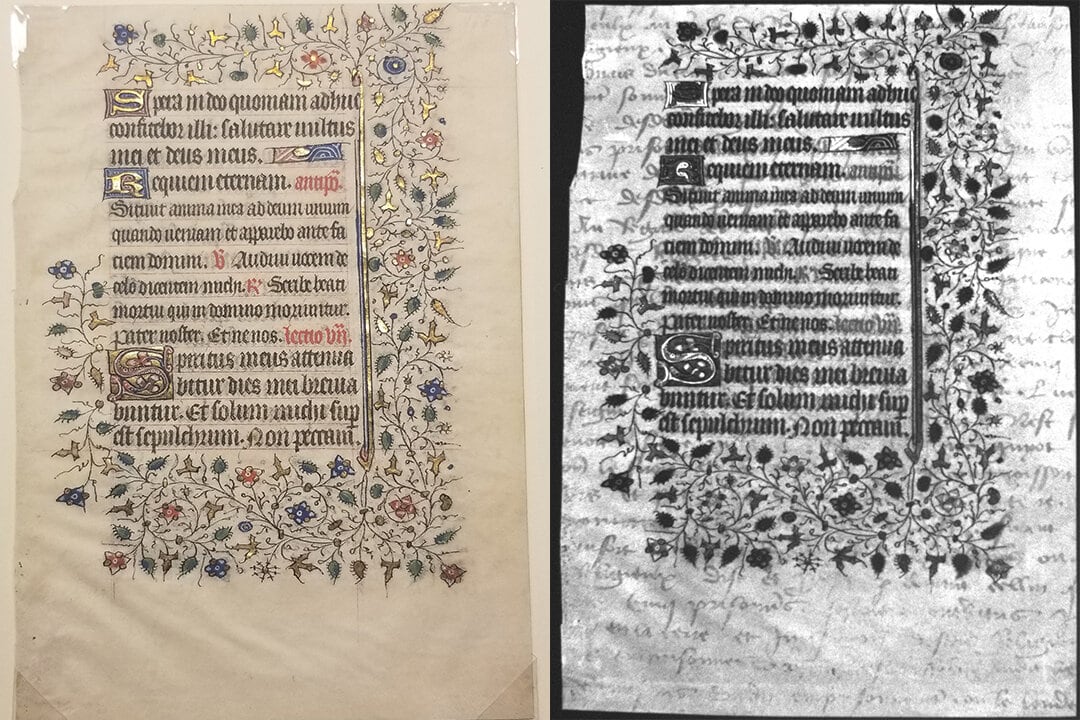Students discover unknown 15th century text hidden in an invisible layer of a medieval manuscript
Categories: Finds and rescue research abroad , Nálezy nejenom s detektorem kovů v USA, severní a jižní Americe

First-year students at the Rochester Institute of Technology in New York have discovered a lost text on the pages of a 15th-century manuscript, which they have traced back to a unique method they developed themselves. Using ultraviolet fluorescence imaging, the students discovered that a manuscript leaf from RIT's Cary Graphic Arts Collection is actually a palimpsest - a manuscript on parchment with multiple layers of...
At the time the manuscript was written, parchment was quite expensive to produce, so sheets were quite commonly scraped or "erased" to be reused. While the erased text is invisible to the naked eye, the chemical trace of the original writing can sometimes be detected using different areas of the light spectrum.
The term "palimpsest" is a compound of two words of Greek origin. Loosely translated, it means "repeatedly scratched". In old manuscripts, the original text was removed from parchment by scraping with a knife or pumice stone, and from papyrus by washing. It was then replaced by the new text. For reasons of economy, such procedures were already used in antiquity and later widespread in the Middle Ages. Palimpsests are very valuable documents for historians because under a special lamp they allow one to read the older scratched text shining through the newer one. As a rule, these are exciting discoveries of new information.
The imaging system was originally built by nineteen first-year students at the Chester F. Carlson Center for Imaging Science Innovation. When RIT went to distance education in March because of the coronavirus, the students were unable to complete the project, but thanks to a donation from Jeffrey Harris and Joyce Pratt, three students received funding to continue their work over the summer. LaLena, Lisa Enochs and Malcom Zale completed the installation of the system in the fall before classes resumed. They immediately began analyzing documents from the Cary collection.
"We borrowed a few parchments from the collection, and when we placed one of them under the modified UV lamp, the dark writing with the amazing French cursive script showed up underneath," said Zoë LaLena, now a second-year student. "It was amazing, this document has been in the Cary collection for about ten years and no one has noticed it yet! And since it also comes from the Ege collection, where another 30 pages from this book are known, it's really fascinatingthat the other 29 pages may also be palimpsests," she added.
The collection is "credited" to collector, educator and historian Otto Ege, who created a set of leaves from medieval manuscripts that were sentkoz koz or incomplete, and sold or donated them to various libraries and special collections across North America, including the Cary Graphic Arts Collection. Collection curator Steven Galbraith said he was excited about the discovery of the palimpsest because similar sheets have been studied in detail by various scholars around the country but have never been screened with similar technology for full display. It will open up new possibilities for many more cultural and academic institutions to discover many more palimpsests to study.
"The students have provided incredibly important information about at least two other manuscript sheets in our collection. In a sense, they have discovered two entirely new texts that we didn't know existed before," Galbraith said. "Now we have to figure out what these texts represent. Spectral imaging in cultural institutions will help with that. To fully understand our own collections, we need to know their depth. This imaging technology reveals all that to us."
The students now plan to find out if other manuscript leaves from Ege collections around the country are palimpsests. At the Buffalo and Erie County Public Library, they imaged another leaf in the Ege collection that turned out to be a palimpsest. They continue to reach out to other curators of collections across the country. Students have been invited to share their results at the International Congress on Medieval Studies in 2021. They also plan to present the project at next year's Imagine RIT Student Festival, themed "Creativity and Innovation."
Video
Roman Němec


Sources: phys.org, archaeology.org, scitechdaily.com
The article is included in categories: